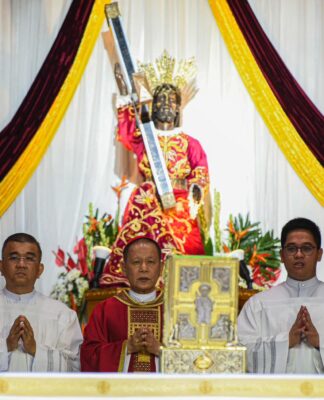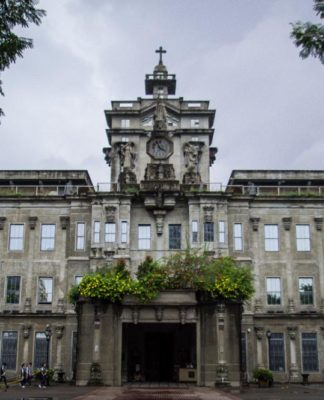FROM heel to hero.
This describes the change in the public’s perception of UST which was cast as a spoilsport when it demanded a retake of the fraud-marred 2006 Nursing board exam whose first anniversary was marked this June.
Critics called UST arrogant, arguing UST wanted a retake since it registered a “mere” 83 per cent in the exam, compared with its previous averages of 90 per cent above.
But UST was vindicated when the Commission on Graduates of Foreign Nursing Schools (CGFNS) said passers of the exams should retake it or else they could not get a permit from the California-based agency to work in the US.
After much hedging, the government ordered a retake of two tests where the leaks allegedly occurred.
College of Nursing associate professor Inocencia Tionko said that the issue was honesty and truth. She added there should be no condoning of cheating.
“In the nursing profession, you are taking care of people’s lives. And you can not cheat people’s lives because there is only one life,” she said.
Tionko added that in nursing care, there’s no rewind button that could undo all mistakes.
“The effect of our nursing care is very direct and immediate,” she said. “If you are not careful, you can not get your patient’s life back.”
Rene Luis Tadle, former president of the Nursing Faculty Association that led other nursing schools in demanding a retake, said UST stood firm for truth and justice.
“Normally, UST just shies away from controversies, but this time we played a pivotal role,” Tadle said. “For us, we did the fighting because of truth, honesty, and integrity. These are the values that animated us from the very beginning.”
After the June 11 and 12, 2006 tests, Baguio takers reported the leaks which were supposed to have been channeled through review schools. The Professional Regulatory Commission (PRC) created an inquiry that confirmed the leaks in Test 3, Medical and Surgical Nursing, and Test 5, Psychiatric Nursing.
But rather than order a retake, the PRC recomputed the exam and allowed passers to take their oath.
UST initially backed the inquiry, but withdrew its support from PRC when the latter ordered the recompute.
“The purpose of UST’s coming out was to support the PRC in identifying the personalities responsible for the leakage,” Nursing dean Glenda Vargas said.
“We thought that once the cheating was confirmed and the perpetrators identified, then the only thing to clear it would be to retake the exam.”
But UST and other critics of the PRC were condemned for their tough stand. Detractors said UST wanted a retake to cover its “low” passing percentage.
But UST insisted a retake was necessary because what was at stake was the reputation of Philippine nurses abroad.
“The June 2006 exam results were not considered official anymore,” Vargas said. “Whether we got a high or low passing percentage, what we were fighting against was the irregularity that surfaced.”
When UST led other schools to the courts to contest the PRC decision, PRC quickly swore in the passers.
The PRC move was also opposed by the Department of the Labor and Employment and Commission on Overseas Filipinos, which backed UST and other schools such as St. Louise University and Far Eastern University in demanding the retake.
The Supreme Court ruled later against the UST stand, citing technicalities.
But the victory of the PRC and no-retake advocates was shortlived.
Last February 14, the CGFNS said it would not grant permits to passers of the June 2006 exam unless they retook Tests 3 and 5.
Although UST was for a retake of the whole exam, public perception was that CGFNS position vindicated UST.
“At first, some of our graduates were not amenable to our stand because all they want is to move on and work,” Vargas said. “When the CGFNS requirement came, then that was the time they started considering a retake.”
Moreover, the American Nursing Association’s (ANA) position that urges Philippine nurses to retake the whole nursing licensure exam reaffirmed the correctness of UST’s stand, Tadle said.
“One event that is important to note but was not given much attention was ANA’s position,” Tadle said. “It is for this reason that most of our students decided to take not only Tests 3 and 5, but the whole exam in order to be associated with the 2007 board takers instead.”
Looking back, Tadle said the scandal led to the administrative intervention of DOLE in PRC and the placement of review centers under the supervision of the Commission on Higher Education (Ched).
“With this kind of revamp, now there can be a kind of oversight that DOLE can do in the decisions of PRC,” Tadle said. “As for Ched, they can now take a closer look at the policies of review centers regarding nursing education.”
Moreover, Tadle stressed that the controversy helped expose the pitfalls of the nursing education system—the rise in the number of students as well as nursing schools sacrificing quality education because of commerce.
Although the scandal rocked and divided the nursing profession, when the smoke of the battle cleared, UST, which has the country’s oldest and most respected nursing school, found itself on the side of history.
“We were able to show that we stand for truth and who else would stand for that except the Catholic University.” Tionko said. “And it just shows the world that we are fully grounded in our values, hindi tayo natinag (we did not falter).” John Constantine G. Cordon













